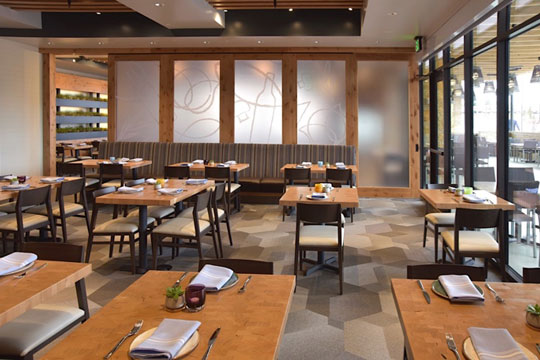Savor Authentic Oriental Food With a Pan-Asian Twist for a Culinary Experience
Beginning on a culinary journey via genuine Eastern food, improved with a Pan-Asian twist, offers an unique chance to explore the rich tapestry of flavors that specify the region's varied culinary customs. As you ponder these tempting meals, think about the cultural stories and historic influences that shape them, each bite providing a story waiting to be found. pan asian restaurant Islamabad.

Exploring Pan-Asian Tastes
In the realm of international gastronomy, Pan-Asian cuisine stands out for its exceptional diversity and the unified interplay of tastes from various Eastern cultures. This cooking approach celebrates the unique components and abundant traditions discovered throughout the continent, developing a tapestry of preferences that is both fascinating and rewarding. Trick to Pan-Asian food is its capability to balance contrasting flavors-- sweet, salty, spicy, and sour-- while highlighting the quality and top quality of each component.
From the umami-rich soy sauce of Japan to the intense chili peppers of Thailand, Pan-Asian cuisine uses an extensive scheme of tastes. These components are often incorporated in inventive means, improving meals with layers of complexity. As an example, using aromatic herbs such as lemongrass and cilantro, typical in Vietnamese and Thai cuisine, includes a refreshing illumination to dishes, while the unification of coconut milk delivers a luscious, rich texture.
The focus on fresh produce and fragrant seasonings makes sure that each meal is not just a feast for the taste however additionally for the detects. Pan-Asian cuisine invites diners to embark on a culinary journey, discovering the huge and varied landscapes of Eastern gastronomy with every bite.
Fusion Recipes to Try
While Pan-Asian cuisine is commemorated for its typical flavors, the modern-day culinary landscape is significantly embracing blend meals that mix these classic elements with impacts from other areas. This cutting-edge technique not only honors the rich heritage of Oriental cookeries however also introduces novel preference experiences that appeal to modern tastes buds.
A prime example of such a fusion dish is the Korean-Mexican taco, where marinaded bulgogi beef is wrapped in a warm tortilla, covered with kimchi and a zesty gochujang-infused salsa. This mix marries the bold, tasty tastes of Korea with the lively, fresh aspects of Mexican cuisine. In a similar way, sushi burritos have gotten popularity, amalgamating the delicate virtuosity of Japanese sushi with the hearty, hand-held ease of a burrito, usually including fusion ingredients like tempura shrimp and avocado with a drizzle of wasabi mayo.
An additional noteworthy meal is Thai curry ramen, which infuses the luscious, fragrant flavors of Thai curry right into the reassuring brew of typical Japanese ramen, producing an unified blend that entices the senses. These blend dishes extend past plain novelty; they stand for a culinary discussion between societies, encouraging exploration and development on the planet of Pan-Asian food.
Essential Components and Seasonings
To truly value Pan-Asian food, one have to comprehend the essential components and seasonings that develop its structure. This diverse culinary style draws from a rich tapestry of Oriental customs, utilizing a harmonious mix of structures and flavors. Key ingredients consist of soy sauce, fish sauce, and oyster sauce, which give a tasty umami deepness necessary to Oriental meals. Corresponding to these are rice vinegar and mirin, providing a fragile level of acidity and sweetness.
Fragrant elements are pivotal, with garlic, site web lemongrass, and ginger being common throughout various Pan-Asian recipes. These components provide a great smelling base that improves the complexity of tastes. Spices such as star anise, cardamom, and cinnamon present heat and personality, resembling impacts from areas like China and India.

Cooking Techniques and Tips
Grasping the art of Pan-Asian food requires familiarity with its distinct cooking methods, each adding pizza bar to the dynamic tapestry of tastes this cooking tradition is celebrated for. Central to these approaches is the stir-fry, a fast food preparation strategy that preserves the nutritional honesty and brilliant shades of ingredients. Making use of a frying pan, the stir-fry approach permits also heat distribution, necessary for accomplishing the characteristic appearance and taste balance of Pan-Asian dishes.
One more basic method is steaming, especially common in Chinese food. This mild method preserves the all-natural flavors and nutrients of components, making it ideal for seafood and veggies. Dumplings, a precious staple, often gain from steaming, causing soft, succulent textures.
Cooking, also important, imparts great smoky midsts to dishes such as Oriental bulgogi or Japanese yakitori (pan asian restaurant Islamabad). This technique commonly involves marinating active ingredients, enabling tastes to permeate deeply before cooking over an open flame or warmer
Lastly, grasping the art of stabilizing flavors-- sweet, sour, salty, bitter, and umami-- is crucial. Properly layering these aspects can boost a meal from regular to amazing, supplying a complicated and pleasing culinary experience that personifies the significance of Pan-Asian food.
Eating Experiences Worldwide
Around the world, Pan-Asian food offers an unrivaled eating experience, celebrated for its rich tapestry of flavors and lively discussions. This cooking phenomenon has actually gone beyond social limits, recording the hearts and tastes buds of food enthusiasts worldwide. In cosmopolitan cities fresh York, click to read more London, and Sydney, Pan-Asian restaurants act as fusions where culinary practices from Thailand, Japan, China, and beyond converge, providing diners with a diverse mix of dishes that highlight the area's diversity.
The global appeal of Pan-Asian cuisine hinges on its capacity to offer both authenticity and advancement. Cooks skillfully marry typical ingredients such as lemongrass, soy sauce, and miso with modern techniques, leading to dishes that are both familiar and refreshingly brand-new. This combination permits restaurants to start a culinary journey that values heritage while welcoming modernity.
In addition, eating experiences are boosted via attentively made settings that show the ethos of Pan-Asian visual appeals. From minimalist Japanese-inspired interiors to vibrant Thai-themed rooms, each dining establishment supplies an one-of-a-kind setting that matches the culinary offerings. Therefore, clients are not simply taking in a meal however partaking in a social experience, making Pan-Asian dining a truly international sensation.
Verdict
The exploration of Pan-Asian food provides an extensive understanding of the detailed interplay of flavors and cooking customs throughout Asia. By accepting blend recipes such as Thai curry ramen and sushi burritos, the cooking journey not just highlights the adaptability of conventional active ingredients but additionally showcases ingenious contemporary techniques. This gastronomic journey, enhanced by cooking techniques and essential flavors, provides a special chance to value the multiculturalism and culinary creativity that define Pan-Asian cuisine on a global scale.
Embarking on a culinary trip with genuine Asian cuisine, enhanced with a Pan-Asian twist, supplies a distinct possibility to explore the abundant tapestry of flavors that define the area's varied cooking customs.In the world of worldwide gastronomy, Pan-Asian food stands out for its remarkable diversity and the unified interplay of flavors from numerous Asian cultures. Trick to Pan-Asian cuisine is its capability to stabilize contrasting tastes-- wonderful, salted, spicy, and sour-- while highlighting the quality and quality of each active ingredient.
